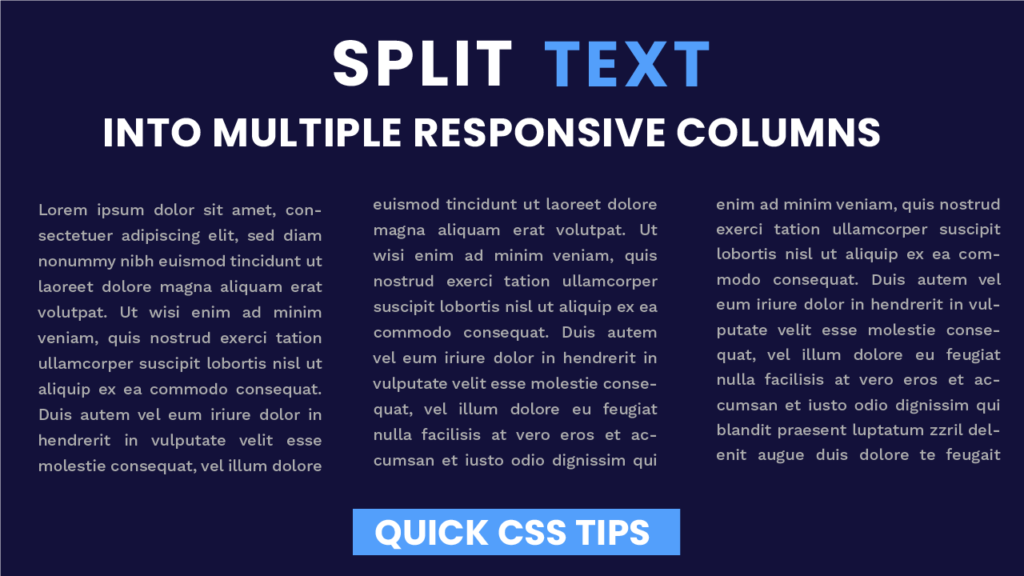
The HTML for CSS grid systems are simpler compared to the HTML for HTML grid systems. The second faction creates their grids in CSS. Their HTML looks like this: Content Sidebar One faction writes grid classes in the HTML (this is how Bootstrap and Foundation does it). The frontend world is split into two factions when it comes to grids systems. Third, will you like to write grid classes in your HTML?. I wrote about these considerations in the same article as well, so give it a read if you’re unsure.

#Html code responsive columns how to
They give you clues on how to calculate your column and gutter widths. You need to answer these questions as well. Will you resize columns and gutters proportionally when viewport width changes? Will you change your columns while keeping gutters fixed? Will you change the number of columns at specific breakpoints? Second, you need to know how your grid behaves at different viewports. Give it a read if you’re want to learn to design a grid. To help you out, I wrote an article about designing grids. You can only make the right grid calculations when you’ve answered the above questions. You need to know three things before building your grid system.Īre you using equal-width or unequal-width columns? How many columns do you have? What’s the size of your gutters and columns? Hopefully you can break away from frameworks and try a custom grid for your next project by the end of this article. So, in this article, I want to help you gain the knowledge and confidence you need to build a custom-made grid. Unfortunately, many people don’t even try building custom grids for their web designs because they lack the knowledge and confidence to build one. You can customize everything you need, including the number of columns, the size of columns and gutters and even the breakpoints you change your layouts at. You can also use display: table-caption along with display:table-header-group and display:table-footer-group to do some complex reordering of multiple columns.Ĭaption-side: top will sit above display:table-header-group and caption-side: bottom will sit below display:table-footer-group.One of the best complement for a custom web design is a custom-made responsive grid system. Remember to use !important if you have inline styles set.column To do this you simply add a class to the column divs, then inside a media query you can set them to display:block. Responsive stackingĬolumns don’t work so well on small viewports so it’s likely you’ll want to stack them. This can work well for a responsive layout if you want one column fixed (maybe containing an image) and one column fluid (maybe containing text). You don’t actually need to define a width, if left undefined it will be generated automatically. Using this method you can add as many columns as you like just repeat this part of the code as many times as you like and adjust the width values. Depending on the styling we may still see a part of that table so we add all:unset opacity:0 to the table styles. To prevent this we first close the MSO table using this conditional comment using false will not render for Outlook. Unfortunately T-online will render all conditional comments, so here it will show both the MSO and the HTML version. Padding:0 " on the if you haven’t cover that in your CSS. You may also need to add in cellspacing="0" cellpadding="0" or style="border-collapse: collapse Here we have a table with 2 columns or 50% width. The MSO Outlook partĪgain if we remove all the conditional comment and HTML code it looks much simpler One advantage for this method is columns can stack without media queries. There are fixes for this but they are delicate and can broken by email client or ESP support. Elements that are inline-block have additional spacing added to them, this mean 2 columns set at 50% width will actually flow onto the next line. Inline-block Can stack columns without any code in the head. This does require a media query of you want the columns to stack. A height of all columns will be determined by the height of the tallest.


Table-cell Can auto fill the width of any columns that don’t have width defined. There are pros and cons to both approaches. You could also just define display:inline-block on the inner divs. Here I’ve used display:table on the outer div and display:table-cell on the inner divs. If you take all the outlook code out of this it’s pretty simple. There are a number of ways of doing this but the one I find to be the most reliable and accessible is Ghost tables. Columns | good-email-code Good Email Code Home ColumnsĬolumns, laying out content beside other content, seems so simple but is one of the hardest things to achieve.


 0 kommentar(er)
0 kommentar(er)
